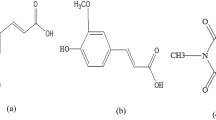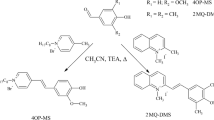Abstract
Luteolin and apigenin, extracted from Reseda luteola L., were spectrophotometrically and fluorimetrically studied. The spectra were investigated as a function of pH in methanol/water solutions (1/2, v/v) in the 2–12 pH range. The absorption spectra markedly shifted to the red by increasing the pH. Three acid–base dissociation steps were detected for luteolin (pK a = 6.9; 8.6; 10.3) and two for apigenin (pK a = 6.6; 9.3). Fluorescence emission was very weak or undetectable (Φ F < 10−4) in acidic solution, but increased in intensity with increasing the pH. Both molecules exhibited a great propensity towards complex formation with metal ions, with association constants on the order of 105–107 for the first complexation step; in the presence of excess Al3+ ions, multiple equilibria were detected. A marked fluorescence enhancement was observed upon complexation with Al3+ ions (Φ F ∼ 1 for luteolin and ∼10−2 for apigenin).









Similar content being viewed by others
References
Cerrato A, De Santis D, Moresi M (2002) Production of luteolin extracts from Reseda luteola and assessment of their dyeing properties. J Sci Food Agric 82:1189–1199
Hofenk de Graaff JH (2004) The colourful past. Abegg-Stiftung and Archetype, London, pp 215–219
Saunders D, Kirby J (1994) Light-induced colour changes in red and yellow lake pigments. Natl Gallery Tech Bull 15:79–97
Wouters J, Rosario-Chirinos N (1992) Dye Analysis of Pre-columbian Peruvian Textiles with High Performance Liquid Chromatography and Diode-Array Detection. J Am Inst Conserv 31:237–255
Miliani C, Romani A, Favaro G (1998) A spectrophotometric and fluorimetric study of some anthraquinoid and indigoid colorants used in artistic paintings. Spectrochim Acta Part A 54:581–588
Miliani C, Romani A, Favaro G (2000) Acidichromic effects in 1,2-di- and 1,2,4-tri-hydroxyanthraquinones. A spectrophotometric and fluorimetric study. J Phys Org Chem 13:141–150
Clementi C, Romani A, Miliani C, Favaro G (2006) In situ fluorimetry: a powerful non-invasive diagnostic technique for natural dyes used in artefacts. Part I: Spectral characterization of orcein in solution, on silk and wool laboratory-standards and a fragment of Renaissance tapestry. Spectrochim Acta Part A 64:906–912
Favaro G, Miliani C, Romani A, Vagnini M (2002) Role of protolytic interactions in photo-aging processes of carminic acid and carminic lake in solution and painted layers. J Chem Soc Perkin Faraday Trans 2:192–197
Shimoyama S, Noda Y (1994) Non-destructive determination of plant dyestuffs used for ancient madder dyeing, employing a three-dimentional fluorescence spectrum technique. Dyes Hist Archaeol 13:14–26
Meech SR, Phillips D (1983) Photophysics of some common fluorescence standards. J Photochem 23:193–217
Thamer BJ, Voigt AF (1952) The spectrophotometric determination of overlapping dissociation constants of dibasic acids. J Phys Chem 56:225–232
Wolfbeis OS, Begum M, Geiger H (1984) Fluorescence Properties of Hydroxy- and Methoxyflavones and the Effect of Shift Reagents. Z Naturforsch 39b:231–237
Seely GR, Jensen RG (1965) Effect of solvent on the spectrum of chlorophyll. Spectrochim Acta 21:1835–1845
Du H, Fuh RA, Li J, Corkan A, Lindsey JS (1998) Photochem CAD: A computer-aided design and research tool in photochemistry. Photochem Photobiol 68:141–142
Herrero-Martinez JM, Sanmartin M, Roses M, Bosch E, Rafols C (2005) Determination of dissociation constants of flavonoids by capillary electrophoresis. Electrophoresis 26:1886–1895
Wolfbeiss OS, Begun M, Geiger H (1987) The fluorescence properties of luteolins. Monatsh Chem 118:1403–1411
Karadag R (2003) Potentiometric and Spectrophotometric Determination of the Stability Constant of Luteolin (3′,4′,5,7-tetrahydroxyflavone) Complexes with Aluminium (III) and Iron (III). Chem Anal (Warsav) 48:931–937
Cornard JP, Merlin JC (2001) Structural and spectroscopic investigation of 5-hydroxyflavone and its complex with aluminium. J Mol Struct 569:129–138
Cornard JP, Merlin JC (2003) Comparison of chelating power in hydroxyflavones. J Mol Struct 651–653:381–387
Cornard JP, Boudet AC, Merlin JC (2001) Complexes of Al(III) 3′4′-dihydroxy-flavone: characterization, theoretical and spectroscopic study. Spectrochim Acta Part A 57:591–602
Porter LJ, Markham KR (1970) Aluminum(III) complexes of hydroxyflavones in absolute methanol. I. Ligands containing only one chelating site. J Chem Soc C: Organic: 344–349
Alluis B, Dangles O (1999) Acylated flavone glucosides: synthesis, conformational investigation, and complexation properties. Helv Chim Acta 82:2201–2212
Deng H, van Berkel GJ (1998) Electrospray Mass spectrometry and UV/Visible spectrophotometry studies of aluminium (III)-flavonoid complexes. J Mass Spectrom 33:1080–1087
Boudet AC, Cornard JP, Merlin JC (2000) Conformational and spectroscopic investigation of 3-hydroxyflavone-aluminium chelates. Spectrochim Acta Part A 56:829–839
Smith GJ, Thomsen SJ, Markham KR, Andary C, Cardon D (2000) The photostabilities of naturally occurring 5-hydroxyflavones, flavonols, their glycosides and their aluminum complexes. J Photochem Photobiol A: Chem 136:87–91
Sathish S, Narayan G, Rao N, Janardhana C (2007) A Self-Organized Ensemble of Fluorescent 3-Hydroxyflavone-Al(III) Complex as Sensor for Fluoride and Acetate Ions. J Fluoresc 17:1–5
Acknowledgements
The research was funded by the Ministero per l’Università e la Ricerca Scientifica e Tecnologica (Rome) and the University of Perugia. One of us (V.V.) is grateful to the Italian Consiglio Nazionale delle Ricerche for a fellowship NATO CNR OUTREACH.
Author information
Authors and Affiliations
Corresponding author
Rights and permissions
About this article
Cite this article
Favaro, G., Clementi, C., Romani, A. et al. Acidichromism and Ionochromism of Luteolin and Apigenin, the Main Components of the Naturally Occurring Yellow Weld: A Spectrophotometric and Fluorimetric Study. J Fluoresc 17, 707–714 (2007). https://doi.org/10.1007/s10895-007-0222-0
Received:
Accepted:
Published:
Issue Date:
DOI: https://doi.org/10.1007/s10895-007-0222-0




